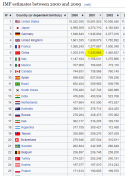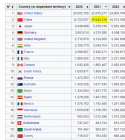China is collapsing.
Yup, this and the Evergrande crisis means its game over for China. Gordon Chang finally wins.
China is collapsing.


In the process of imminent collapse:

China is negotiating with Saudi Arabia to buy 2% of Aramco shares, worth $100 billion
DrJekyl
I have been thinking of how the money issuing matter works in international trade. Here is the thought.What I see is China dumping $100bln soon to be useless US dollars for a stake in the largest oil company in the world;
not to mention the potential for Saudi to be a prime Chinese arms market
Why don't they just print $100billion worth of rmb and do a currency swap for doing this deal?I have been thinking of how the money issuing matter works in international trade. Here is the thought.
In a perfect balanced market, there is only one authority issuing printed money that equals to the size of product circulating the market. Let's say there are 1000 clothes and 1000 kg rice produced in last year, there should have been equivalent amount of money for that 1000 clothes and 1000 kg rice, let's say 20'000 RMB (10 rmb per cloth, 10 RMB per kg rice). After all these products are bought, the 20'000 RMB money should be returned to the bank, sitting in the vault. If this year, the production remains, these 20'000 will be used for the circulation again. If the production increased by 10%, there is a need to print 2000 RMB to represent that increase. The total amount of money in the economy becomes 22'000. There is no inflation and devaluation of the money.
It is not just about what China want, but the other end has to be willing. For the other end, they still see the need of USD in the near future. The de-dollarization is not an event can be forced on the world over night. That kind of thing only happens when a single authority like national central bank forced everyone to switch the older version of the print with newer one.Why don't they just print $100billion worth of rmb and do a currency swap for doing this deal?
Watch that 9 year old video which shows how India would like to be "when" it became economically powerful (lol).
India being a caste society was always going to have a “deep state” along the lines of Anglo style feudalism and oligarchy; given the Anglo sympathisers in India and the jealousy and hatred by India forwards China, even a “non aligned” India will be hostile to China.
